What are they capillary vascular malformations?
Capillary vascular malformations (telangiectatic naevi or nevi) are sometimes incorrectly called blueprints hemangiomas. These are not hemangiomas but dilated malformed blood vessels on the skin The lesions are not cancerous and appear as red or purple discoloration spots on the skin anywhere on the body. They are always present at birth, although they may become more apparent over time. They can range in size from a small point to occasionally involving an entire limb, and grow in proportion to the child's overall growth.
Types of capillary vascular malformation
Two common capillary vascular malformations are nevus simplex (salmon patch) and the port wine stain (naevus flammeus).
Naevus simplex
Naevus simplex is very common and occurs in approximately 40% of all newborns. They are usually small flat spots of pink or red skin with poorly defined edges. They are commonly found at the nape of the neck (stork bite, erythema nuchae), on the forehead between the eyebrows (angel kiss) or on the eyelids. They become more intense in color and are noticeable when the child is crying. Most injuries will disappear spontaneously within the first year of life. Stork bites tend to be more persistent and can remain unchanged into adult life in 50% cases.
Salmon patches
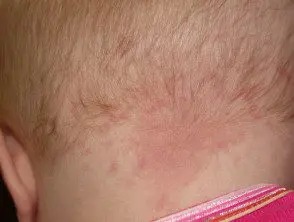
Salmon patch

Salmon patch
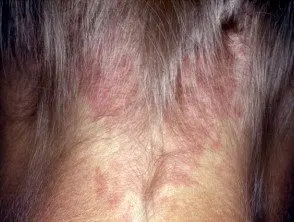
Salmon patch
Puerto Mancha wine
Port wine stains are much less common than salmon patches, and occur in approximately 0.3% of newborns. A port wine stain is usually a large flat patch of purple or dark red skin with well defined boundaries At birth, the surface of the Port wine stain is flat, but over time it becomes uneven and often uglier. The face is affected more frequently, although it can occur anywhere on the body. When present, they generally appear on one side of the body with a sharp midline cut.
Some port wine stains may fade over time, but most remain unchanged or may even intensify in color. They do not shrink on their own or disappear spontaneously. If the port wine stain affects the face and neck, it can have a severe impact on the child's social, psychological and economic development.
Port wine stains
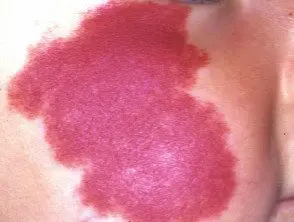
Puerto Mancha wine

Puerto Mancha wine
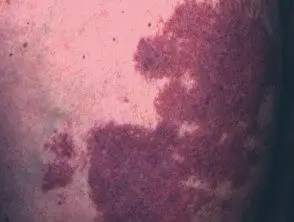
Puerto Mancha wine
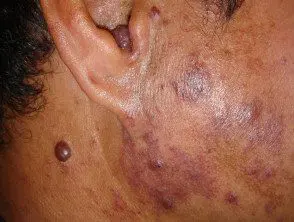
Puerto Mancha wine

Puerto Mancha wine
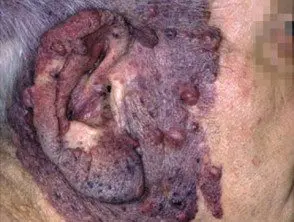
Puerto Mancha wine
Vascular syndromes
Most capillary vascular nevi are not associated with other abnormalities. However, there are some rare syndromes that can occur with this type of birthmark:
- Sturge-Weber syndrome
- Parkes Weber syndrome
- Klippel-Trénaunay syndrome
- Hyperkeratotic cutaneous capillary-venous malformation
- Proteus syndrome
Sturge-Weber syndrome is also known as encephalotrigeminal angiomatosis. It is the association of capillary vascular malformation that affects the skin irrigated by a branch of the trigeminal nerve of the face with defects in the underlying tissues. This can result in a shrunken brain, calcification inside the skull, seizures, meningeal angioma and ocular abnormalities (glaucomaoptics atrophy) Sturge-Weber syndrome is due to somatic mutation at gene GNAQ.
Parkes-Weber syndrome refers to the association of a capillary vascular malformation with an arteriovenous malformation. The birthmark tends to be quite large. It is often faint pink, but can also be bright red. The affected limb is warmer and longer than the other side, although normally. It is possible to feel an "emotion" due to the high blood flow through the arteriovenous malformation. The doctor who listens with a stethoscope may hear an oscillating or "puff" sound. Occasionally there is an enlarged heart, which can lead to heart failure.
Klippel-Trénaunay syndrome refers to the association of a capillary vascular malformation with a venous and a lymphatic malformation. The shallow red birthmark tends to be small or irregular but prominent. The lymphatic malformation may contain large fluid-filled cysts (macrocystic) or small groups (microcystic). The affected limb is wider and more bulky than the other side, and sometimes longer. Sometimes the affected limb is smaller than the other. The syndrome can be complicated by blood clots (thrombophlebitis), lymph leak, infections (cellulitis), ulceration and bleeding
Capillary-venous cutaneous hyperkeratotic malformation generally affects the tissues around the eye. It can be associated with vascular malformations in the brain, known as "cavernomas." This disorder is inherited as a autosomal dominant abnormality, affecting half of the children of an affected person. It is due to a mutation in a gene called KRIT1.
Proteus syndrome is very rare and is believed to be due to abnormal PTEN. tumor-suppressor gene. It has highly variable manifestations, such as enlarged hands and feet, or one side of the body, various birthmarks including vascular malformations, connective tissue naevi epidermal nevi, skull abnormalities, and fatty tumors (lipomas) under the skin and internally.
Other vascular capillary malformations
Reticulated vascular nevi They are closely related to port wine stains. The main difference is that reticulated nevi generally improve spontaneously as they fade over time.
Reticular vascular nevus

Reticular vascular nevus
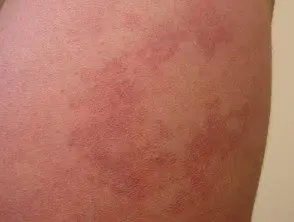
Reticular vascular nevus
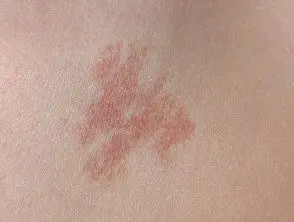
Reticular vascular nevus
Angiokeratoma circumscribed it's a raised warty dark purple red injury that is most commonly found on the lower leg or foot. It is often covered in rough scaly skin patches. In many cases, they are present at birth, but can also develop in childhood or adulthood. Angiokeratomas they are harmless lesions that generally do not require treatment. For aesthetic reasons or concerns of a possible melanoma, surgical removal, or To be Therapy can be performed.
Angiokeratoma circumscriptum
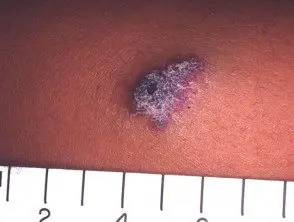
Angiokeratoma
What is the cause of capillary vascular malformation?
Capillary vascular malformations are now known due to genetic abnormalities and are often family. Researchers have found a mutation in the GNAQ gene in chromosome 9q21 in the vast majority of patients with port wine stains and Surge-Weber syndrome. [2]
What research should be done?
Capillary vascular malformations are generally diagnosed clinically and investigations are not required for most flat injuries. However, when there is uncertainty about the diagnosis or if the underlying tissues are affected, a ultrasound The scan is often done. Characteristically, a vascular malformation shows blood vessels placed in normal fundus tissue.
In more complicated cases it may be necessary to perform Magnetic resonance imaging (Magnetic resonance) or angiography to help plan treatment.
What is the treatment of capillary vascular malformation?
Salmon patches do not require treatment, while treatment of port wine stains depends on the body site, extent, and nature of the injury. In the past, a cosmetic cover was the best advice for those affected, but now many can be successfully removed or their appearance improved with laser treatment. Specialist advice and referral for treatment are best before entering school, when possible.
Pulsed dye laser (PDL) appears to be the treatment of choice for most port wine stains. Approximately 40–45% improves by at least 75% after 5 to 25 treatments. Some injuries that do not respond to a PDL may improve when treated with other types of lasers.
Capillary vascular malformations may bleed after minor trauma and sometimes the bleeding can be difficult to stop despite the application of pressure. This is rare
Complex syndromes require careful evaluation, often by a team of specialists who may include a pediatric dermatologist, pediatrician, radiologist, plastic surgeon and / or vascular surgeon. The following measures may be rarely necessary:
- Compression stockings or bandages to reduce swelling and protect against injury.
- Aspirin, and sometimes blood thinners like warfarin, to prevent clots
- Resection or ligation (fixation) of abnormal blood vessels
- Sclerotherapy to treat varicose veins
- Bone shortening operation if one limb is more than 2 cm longer than its pair
- Amputation of a very abnormal digit (finger or thumb) or limb
Oral sirolimus (which inhibits angiogenesis) is being investigated as a possible medical treatment for severe vascular malformations, but may have significant adverse effects [1].
Effect of laser treatment on a vascular malformation.
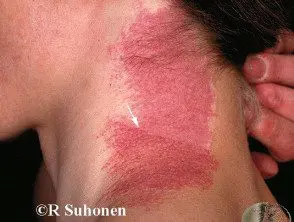
Puerto Mancha wine
See more images of vascular malformations.

